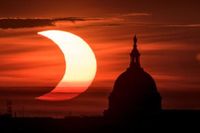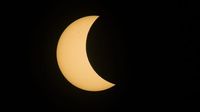As the sun rises on Saturday, March 29, 2025, early risers across parts of North America and Europe will be treated to a rare celestial display: a partial solar eclipse. This event, which begins globally at 4:50 a.m. EDT (8:50 a.m. GMT) and concludes at 8:43 a.m. EDT (12:43 p.m. GMT), will offer a unique spectacle, particularly in the northeastern United States where viewers can expect a 'double sunrise' effect.
According to Prof. Darren Baskill, an astronomy lecturer at the University of Sussex, "From wherever you see the eclipse, it will be a wonderful sight. It reminds us of the mechanics and natural rhythms of our solar system." For many, this partial eclipse is a chance to witness the moon partially obscuring the sun, creating an enchanting visual reminiscent of a bite taken out of the sun.
In New Jersey, the partial eclipse will begin around 5:22 a.m. and reach its peak at approximately 6:47 a.m., before concluding by 7:02 a.m. The extent of the obscuration will vary across the state, with estimates ranging from 14% to 22% of the sun's surface being covered.
Areas along the East Coast, particularly in Maine, will experience the most dramatic views, with up to 85% of the sun obscured in some locations like Presque Isle. This significant coverage will allow for the illusion of two suns rising, known as the 'double sunrise' effect. As the crescent sun rises, the two pointed tips of the crescent will appear to rise separately above the horizon, creating a striking visual that has been likened to 'devil's horns.'
Prof. Peter Gallagher, a solar physicist at the Dublin Institute for Advanced Studies, adds, "It’ll look quite weird. Instead of seeing a semicircle coming up as you would normally, there’ll be a bite out of it. That’ll be really cool looking, for sure." This unique phenomenon is expected to be visible from various locations along the northeastern coast, including parts of New Jersey, where viewers may not see the full effect but will still experience a beautiful sight.
To safely enjoy the partial solar eclipse, it is crucial to use certified eclipse glasses or solar filters on cameras and telescopes. Regular sunglasses are not sufficient for protection against the sun's rays. NASA has issued clear guidelines for safe viewing, emphasizing that viewers must wear eclipse glasses at all times while looking at the sun. Additionally, it is advised not to look at the eclipse through unprotected optical devices, as this can cause serious eye damage.
For those who do not have access to eclipse glasses, there are alternative methods to view the event safely. One popular technique involves creating a pinhole projector, which allows observers to see the eclipse indirectly. This method is both simple and effective, providing a safe way to enjoy the celestial show.
The weather on March 29 will play a crucial role in the viewing experience. In North Jersey, forecasts predict 95% cloud cover overnight leading into the morning hours, with a 55% chance of showers. By the time the eclipse begins, conditions may improve slightly to partly sunny skies with a lower chance of rain. In contrast, South Jersey is expected to have clearer skies, making it a more favorable location for viewing.
More than 800 million people will be within some portion of the eclipse's path, which will be visible across 14 U.S. states, including Connecticut, Delaware, Maryland, Massachusetts, New Hampshire, New York, North Carolina, Pennsylvania, Rhode Island, Virginia, and West Virginia, as well as Washington D.C. and parts of eastern Canada. This expansive coverage means many will have the opportunity to witness this celestial event.
For those unable to experience the eclipse in person, there are options to watch it live online. Various organizations, including the Royal Observatory Greenwich, will be streaming the event, providing an opportunity for sky watchers to enjoy the spectacle from the comfort of their homes.
As the eclipse approaches, excitement is building among astronomy enthusiasts and casual viewers alike. The last total solar eclipse in April 2024 left many in awe, and while this upcoming event is a partial eclipse, it promises to be equally captivating. With the right conditions and preparations, viewers can expect a breathtaking display that illustrates the wonders of our solar system.
In summary, the partial solar eclipse on March 29, 2025, offers a unique opportunity for millions to witness a beautiful celestial phenomenon. Whether you are in New Jersey or Maine, ensure you have the proper safety equipment and a clear view of the horizon to fully enjoy this spectacular event. With the chance to see a 'double sunrise' and the moon taking a bite out of the sun, this is a morning that is sure to be remembered.



